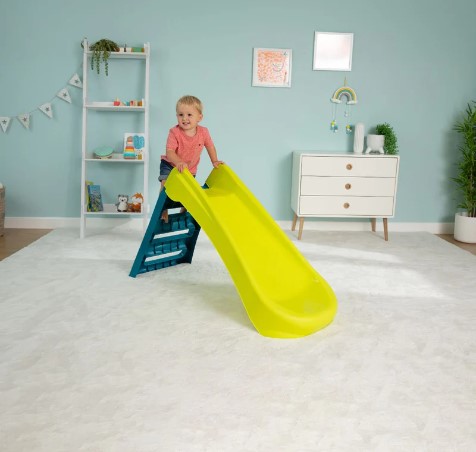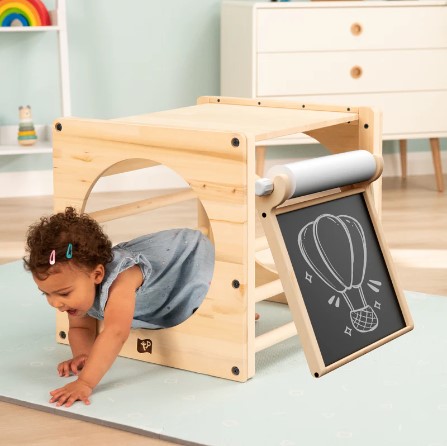Imaginative play is an essential part of early childhood development, helping toddlers explore the world, develop problem-solving skills, and build creativity. As parents, you have a unique opportunity to nurture your child’s creative thinking by providing them with the right environment and tools. While you don’t need expensive equipment or complex setups, simple nursery toys and outdoor items like a garden slide for kids can spark a toddler’s imagination.
Here are some practical tips to encourage creative thinking and imaginative play in young children.
Table of Contents
- Create a Stimulating Environment
- Encourage Role-Playing Games
- Use Everyday Objects as Toys
- Read and Tell Stories Together
- Allow for Unstructured Playtime
- Be Encouraging, Not Controlling
Conclusion
- Create a Stimulating Environment
Your home and garden can become an adventure zone for your toddler’s imagination. Start by creating spaces that invite curiosity and exploration. Whether it’s their nursery, playroom, or garden, ensure there are open-ended toys, such as building blocks, soft dolls, or stacking toys. These toys can be used in a variety of ways, encouraging toddlers to come up with their own games.
Outdoor play areas are equally important. A garden slide for kids is a great addition, as it’s not just a slide – in your toddler’s mind, it can become a mountain, a spaceship, or a waterfall! Children often use slides to act out stories, and climbing up and sliding down repeatedly allows them to stretch their physical abilities while engaging their imagination.
- Encourage Role-Playing Games
Role-playing is an excellent way to encourage creative thinking. Toddlers love to mimic adults and take on new roles, which helps them understand the world around them. By providing nursery toys that allow for role-playing, like toy kitchens, doctor’s kits, or toolsets, you give your toddler the means to pretend they are someone else. These toys allow them to create scenarios where they can “cook dinner”, “fix a broken toy”, or “look after a baby”.
You can also join in their play, which can boost their imagination even further. By asking questions like, “What are we making in our kitchen today?” or “How can we fix this toy?”, you prompt your toddler to think creatively and come up with different solutions.
3. Use Everyday Objects as Toys
Not all imaginative play requires formal toys. Everyday household objects can spark creativity in surprising ways. A cardboard box can become a car, a fort, or a pirate ship, while a wooden spoon and a saucepan can turn into a drum kit. Let your toddler experiment with these items, and don’t be afraid of messes – creative thinking often thrives in environments where children are free to explore and experiment.
Similarly, outdoor objects in your garden can become part of their imaginative play. A garden slide for kids, combined with some soft toys, can transform into a grand safari where toys take turns “sliding down the mountain” in a dramatic adventure. Leaves, sticks, and stones can be “ingredients” for a pretend meal or building materials for a tiny house. The more freedom your child has to explore the world around them, the more
4. Read and Tell Stories Together
Books are one of the best tools for inspiring imagination in toddlers. Regularly reading to your child helps them understand different scenarios, characters, and adventures, which they can then apply to their own play. Choose books with rich illustrations, exciting characters, and imaginative plots, and encourage your toddler to tell their own version of the story afterwards. This helps them develop creative thinking and narrative skills.
You can take it a step further by creating your own stories together. Ask your toddler to describe what happens next in the story or to invent a new adventure for their favourite character. As they get more confident, they may even want to act out parts of the story using their toys or the nursery toys you have at home.
5. Allow for Unstructured Playtime

In our busy lives, it’s easy to fill up a toddler’s day with structured activities like classes or outings. However, unstructured playtime is essential for creative thinking. When toddlers are given free time without adult-directed activities, they learn to entertain themselves, which often leads to imaginative play.
Make sure your child has plenty of time to play without interruptions and resist the urge to guide their activities. Whether they’re playing with nursery toys indoors or exploring the garden slide for kids outside, allowing them to take charge of their play nurtures their independence and creative thinking.
6. Be Encouraging, Not Controlling
Finally, remember that every toddler has their own unique way of playing and exploring. As parents, it’s important to encourage your child’s imagination without controlling it. Offer gentle guidance when needed, but try not to dictate how they should play or use their toys. When they come up with unusual or unexpected ideas, show interest and ask questions. For example, if they’ve decided that the garden slide for kids is a spaceship, ask them where it’s flying to or what they can see from the top.
In doing so, you reinforce their creative thinking, helping them feel confident in their imaginative abilities.
Conclusion
Creative thinking in toddlers can be nurtured through simple activities and toys. Whether using a garden slide for kids in the garden or enjoying nursery toys indoors, imaginative play plays a crucial role in your child’s development. By creating a stimulating environment, encouraging role-play, reading stories, and allowing for unstructured playtime, you’ll help your toddler develop skills that will serve them throughout their lives.

